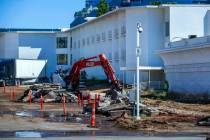Border towns say violent crime rates low
NOGALES, Ariz. -- Assistant Police Chief Roy Bermudez shakes his head and smiles when he hears politicians and pundits declaring that Mexican cartel violence is overrunning his Arizona border town.
"We have not, thank God, witnessed any spillover violence from Mexico," Bermudez says emphatically. "You can look at the crime stats. I think Nogales, Ariz., is one of the safest places to live in all of America."
FBI Uniform Crime Reports and statistics provided by police agencies, in fact, show that the crime rates in Nogales, Douglas, Yuma and other Arizona border towns have remained essentially flat for the past decade, even as drug-related violence has spiraled out of control on the other side of the international line. Statewide, rates of violent crime also are down.
While smugglers have become more aggressive in their encounters with authorities, as evidenced by the April 30 shooting of a Pinal County deputy, allegedly by illegal immigrant drug runners, they do not routinely target residents of border towns.
In 2000, there were 23 rapes, robberies and murders in Nogales, Ariz. Last year, despite nearly a decade of population growth, there were 19 such crimes.
Aggravated assaults dropped by one-third. No one has been murdered in two years.
Bermudez said people unfamiliar with the border may be confused because Nogales, Sonora, has become notorious for kidnappings, shootouts and beheadings. With 500 Border Patrol agents and countless other law officers swarming the Arizona side, he said, smugglers pass through as quickly and furtively as possible.
"Everywhere you turn, there's some kind of law enforcement looking at you," Bermudez said. "Per capita, we probably have the highest amount of any city in the United States."
In Yuma, police spokesman Sgt. Clint Norred said he cannot recall any significant cartel violence in the past several years. Departmental crime records show the amount of bloodshed has remained stable despite a substantial population increase.
"It almost seems like Yuma is more of an entryway" for smugglers rather than a combat zone, he said.
Since the murder of Cochise County rancher Robert Krentz by a suspected illegal immigrant in March, politicians and the national press have fanned a perception that the border is inundated with bloodshed and that it's escalating.
Congressional members, including Gabrielle Giffords, D-Ariz., and John Shadegg, R-Ariz., sent President Barack Obama a letter asking that National Guard soldiers be sent to the border because "violence in the vicinity of the U.S.-Mexico border continues to increase at an alarming rate."
And last month, as she signed Arizona's tough new law cracking down on illegal immigrants, Gov. Jan Brewer also called for National Guard troops. The law makes it a state crime to be in Arizona illegally and requires authorities to check documents of people they reasonably suspect to be illegal. Brewer said she signed it to solve what she said is an Arizona "crisis" caused by "border-related violence and crime due to illegal immigration."
Clarence Dupnik, the sheriff of Pima County, said there always has been crime associated with smuggling in southern Arizona, but today's rhetoric does not seem to jibe with reality.
"This is a media-created event," Dupnik said. "I hear politicians on TV saying the border has gotten worse. Well, the fact of the matter is that the border has never been more secure."
Even Cochise County Sheriff Larry Dever, among the most strident critics of federal enforcement, concedes that notions of cartel mayhem are exaggerated.
"We're not seeing the multiple killings, beheadings and shootouts that are going on on the other side," he said.
In fact, according to the Border Patrol, Krentz is the only American murdered by a suspected illegal immigrant in at least a decade within the agency's Tucson sector, the busiest smuggling route among the Border Patrol's nine coverage regions along the U.S.-Mexico border.
Still, Dever said, the slaying proved useful to southern Arizonans who are sick of smugglers and immigrants tramping through their lands.
"The interest just elevated. And we keep the pressure on because next week something else is going to happen, and the window of opportunity will close," Dever said.
Cochise County's crime rate has been "flat" for at least 10 years, the sheriff added. Even in 2000, when record numbers of illegal immigrants were detained in the area, just 4 percent of the area's violent crimes were committed by illegal immigrants.
While the nation's illegal immigrant population doubled from 1994 to 2004, according to federal records, the violent-crime rate declined 35 percent.
More recently, Arizona's violent-crime rate dropped from 512 incidents per 100,000 residents in 2005 to 447 incidents in 2008, the most recent year for which data is available.
In testimony to the Senate Committee on Homeland Security last month, Dennis Burke, U.S. attorney for Arizona, noted that Arizona now has more than 6,000 federal law-enforcement agents, with the majority of them employed by the Border Patrol.
That represents nearly 10 agents for every mile of international line between Arizona and Sonora.
Border Patrol presence has been backed by increases in counter-smuggling technology and intelligence, the establishment of permanent highway checkpoints and a dramatic increase in customs inspectors at U.S. ports.
RACIAL PROFILING FEARED
WASHINGTON — Attorney General Eric Holder says he does not think Arizona’s law cracking down on illegal immigrants is racially motivated but says he fears enforcement could lead to racial profiling.
Holder also said the United States has a national immigration problem that cannot be cured with a “state-by-state solution.”
The top U.S. prosecutor said he understands the frustration behind the Arizona law, but warns the country could get on a slippery slope with people “picked on” because of how they look instead of what they’ve done.
Holder spoke Sunday on ABC’s “This Week” and NBC’s “Meet the Press.”
THE ASSOCIATED PRESS























